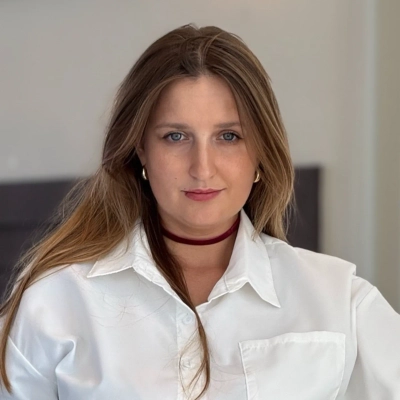How to Encourage Internal Mobility Within Your Organization
Unlocking the potential of an organization's workforce requires innovative strategies for internal mobility. This article delves into proven methods, enriched with insights from industry experts, to facilitate career progression and skill development across various levels. Learn how to create a dynamic, growth-focused environment that cultivates talent from within.
- Create Clear Career Pathways
- Encourage Cross-Training
- Recognize Team Strengths
- Provide Structured Skills Development
- Foster Continuous Learning
- Craft Personalized Career Pathways
- Offer Monthly Role Rotations
- Invest in Continuous Learning
- Use Gamified Learning Tools
- Implement Structured Talent Development
- Create Continuous Learning Environment
Create Clear Career Pathways
One practice I've implemented to encourage internal mobility within our organization is creating clear career pathways and development programs for employees. We've set up a mentorship program where senior leaders work closely with employees to help them identify their career goals, understand the skills they need to advance, and provide the support they need to grow within the company.
This approach has been really empowering for our employees. They feel more in control of their career progression and have the tools to pursue new roles or responsibilities within the organization. We also actively promote internal job postings and encourage employees to apply for roles that align with their interests and strengths. It's all about creating a culture of growth and opportunity.
The results have been great—it's not just about improving retention; it's about building a motivated, skilled workforce that's already deeply connected with our company's values and operations. It's been so rewarding to see people grow within the company and continue to contribute in new and exciting ways.

Encourage Cross-Training
In my experience as the owner of Detroit Furnished Rentals, I prioritize internal mobility by encouraging employees to explore diverse roles that align with both their interests and business goals. This approach is crucial, especially in an industry where adaptability can improve operational efficiency and customer satisfaction. One practice I've implemented is cross-training team members in different areas—like property management, guest relations, and marketing—allowing them to gain a comprehensive understanding of our operations.
For instance, I had a team member initially focused on guest relations express interest in the marketing side. By involving them in creating our "Game Night Getaway" package, they gained hands-on experience with promotional strategies and improved our marketing efforts. This not only boosted their career development but also contributed to increased bookings and improved customer engagement.
Additionally, I emphasize open communication to identify team members' aspirations and how their roles can evolve. By doing so, I ensure my team feels valued and motivated, which improves the overall business atmosphere and helps in retaining capable talent. This strategy has been instrumental in keeping my business dynamic and responsive to changes in the market.

Recognize Team Strengths
At Ozzie Mowing and Gardening, encouraging internal mobility is about recognizing the strengths of each team member and creating opportunities for them to grow within the business. One practice we've implemented is cross-training our team across different areas of gardening, landscaping, and lawn care. This approach not only ensures that our team is highly versatile, but it also allows individuals to explore their interests and talents in various aspects of the work. For example, a team member who started with basic lawn mowing showed a strong interest in landscape design. Through mentoring sessions and hands-on experience, we were able to develop their skills, and now they play a key role in planning and executing our more creative projects.
With over 15 years of experience in the industry and a certification in horticulture, I've been able to guide these internal transitions by providing the training and insights needed to help my team succeed. My background in both the practical and theoretical sides of gardening allows me to mentor effectively, identifying not just technical skills but also a passion for certain tasks. This focus on internal growth has led to a more engaged and skilled team while fostering loyalty and collaboration. By investing in our people, we've built a business culture that's as nurturing as the gardens we create.
Provide Structured Skills Development
At Ponce Tree Services, we encourage internal mobility by identifying and nurturing the unique strengths of our team members while providing clear pathways for growth. One practice we've implemented is structured skills development programs, where employees are cross-trained in different aspects of tree care, safety protocols, and equipment operation. For example, a crew member who starts with groundwork might be given the opportunity to train as a climber or equipment operator. We regularly evaluate team members' progress, and based on their strengths and interests, we guide them toward roles that align with their career aspirations. This not only enhances their skill sets but also ensures they feel valued and invested in the company. Additionally, we provide mentorship opportunities where our experienced arborists work closely with newer employees to pass on knowledge and expertise. My years of experience and certification as an arborist and TRAQ specialist have played a key role in fostering this culture of growth. Having learned the trade hands-on from an early age and worked my way through the ranks, I understand the importance of providing opportunities to grow within the business. This approach has created a motivated team, reduced turnover, and ensured we have highly skilled employees ready to step into new roles, keeping our operations strong and our customers satisfied.

Foster Continuous Learning
At Twin City Marketing, encouraging internal mobility is about fostering a culture of continuous learning and adaptability. One practice we've implemented is creating skill-sharing workshops where team members can teach and learn from each other across different areas of expertise. For instance, our analytics team recently ran a session on using data to boost digital PR strategies, which allowed colleagues from content and SEO teams to gain new insights and skills.
Furthermore, we support career mapping during performance reviews, helping employees identify potential career paths within the company that align with their evolving interests and strengths. This not only empowers employees to pursue growth opportunities but ensures we retain talent by actively investing in their career development.
Additionally, I encourage cross-departmental collaborations on projects, which exposes team members to different roles and responsibilities. For example, during a major digital campaign for a client, we had PR and content specialists work alongside our technical SEO team, leading to innovative approaches and personal skill growth. This practice keeps our team dynamic and responsive to both their professional aspirations and market demands.
Craft Personalized Career Pathways
To encourage internal mobility at UpfrontOps, I focus on crafting personalized career pathways for each team member. This involves regular performance reviews and career talks, where we map out individual skills and interests against potential internal opportunities. It's about aligning personal goals with business needs, allowing for organic role transitions.
One successful example was when a team member with a knack for data relocated from a customer support role to our analytics team, contributing to our 73.3% year-over-year growth with valuable insights. These transitions are further supported by our operational model that emphasizes cross-departmental projects, giving employees the chance to work outside their usual roles and build diverse skill sets.
Additionally, I implement a microservice approach where employees can take on small, impactful projects without a long-term commitment. This way, they get to experience different functions within the company, making it easier to find where they truly excel and wish to contribute in the long term, fostering a more dynamic and adaptable workforce.

Offer Monthly Role Rotations
Monthly rotations offer team members a chance to step into a different role for a month. Each shift brings a fresh perspective and builds new connections. I set up clear schedules that let everyone see a different side of our operations. Team members exchange ideas and learn hands-on, sparking growth and excitement.
Team members volunteer to try a new role, gaining a real feel for other functions. Feedback from each rotation helped us refine our approach and build a tighter network internally. New skills emerge naturally when people experience different challenges. Rotations bring energy and curiosity to the team, and I've seen it work wonders.

Invest in Continuous Learning
At SuperDupr, encouraging internal mobility is crucial to our success. I've found that investing in continuous learning for our team helps tremendously. For instance, we regularly organize workshops and provide resources on the latest tech trends, from AI integration to blockchain utilization. This not only sharpens skills but also allows team members to explore new roles and responsibilities.
Additionally, I foster an environment of open communication and collaboration. When we worked on the Unmooring project, team members from different departments could pitch in and contribute creatively, which promoted cross-functional learning. This practice ensures our staff can seamlessly move within the organization, pursuing career growth and interests.
Finally, I prioritize mentorship and support from experienced colleagues. My active role in mentoring emerging entrepreneurs outside SuperDupr mirrors our organization's internal approach. Providing guidance and real-world challenges to tackle helps team members grow organically into new roles, enhancing satisfaction and retention.

Use Gamified Learning Tools
Internal mobility is key to a vibrant workplace culture, and at Give River, we integrate it seamlessly through our platform's learning and growth tools. We use our Learning Management System and "River Runs" mini-courses to encourage continuous personal and professional development, which naturally supports internal mobility. These gamified learning experiences not only improve skills but also inspire employees to pursue new roles within the company by making training engaging and accessible.
I often highlight the importance of aligning career development with personal interests to prevent burnout, as discussed in my podcast, "Don't Just Manifest, Megafest." By offering gamified, customized training with real-time feedback and incentives, we create an environment where employees feel supported to explore different pathways within the company. This is not only motivational but can directly lead to transitions across departments.
A remarkable example from our platform is how a client used our guidance and recognition tools to help team members transition from administrative roles to creative ones. This was achieved by leveraging our "Drop Shop" rewards to incentivize participation in creative skills courses, significantly reducing turnover and boosting engagement. This model can be replicated in any organization looking to harness internal talent and encourage growth from within. Internal mobility is a crucial element of how we foster personal and professional growth at Give River. We've integrated gamified learning tracks that not only motivate but also empower employees to take charge of their career paths. Through our Learning Management System (LMS), individuals can opt into "River Runs," our short courses designed to upskill and expose them to new roles.
For instance, one of our team members, initially in a customer support role, used the "Leadership Fundamentals" course. By engaging with gamified content and earning "drops" for completion, they were able to transition into a leadership position within six months. This generated not only career progression but also invigorated their team with new energy and ideas.
We see internal mobility as a way to retain talent and nurture leadership from within. Recognizing and celebrating these personal achievements publicly in our team culture fosters a space where employees feel valued and motivated to pursue growth. This approach not only lifts individual capabilities but drives collective team success.

Implement Structured Talent Development
One of the most effective practices I've implemented to encourage internal mobility is creating a structured talent development program that includes mentorship, cross training, and regular performance reviews with clear growth pathways. In one of my businesses, I noticed employees were eager to grow but lacked clarity on how to advance within the organization. Drawing from my experience building teams in telecommunications and coaching hundreds of entrepreneurs, I designed a framework that focused on aligning employee strengths with future business needs. For example, I encouraged team members to rotate roles within departments for short periods to gain exposure to different aspects of the business. This not only broadened their skillsets but also revealed hidden talents and leadership potential that might otherwise have gone unnoticed.
One standout success was a junior sales associate who showed promise but was underperforming due to a lack of engagement. Through mentorship and a cross-functional assignment in operations, he discovered a talent for logistics and eventually became the head of that department, driving significant improvements in efficiency and cost reduction. My MBA in finance and years of working with diverse business owners taught me how to assess potential, coach individuals effectively, and build systems to support ongoing development. The result was a stronger, more motivated team with lower turnover and a culture that valued growth from within. Internal mobility isn't just about promotions; it's about unlocking the potential of your people while aligning it with your business goals. This approach not only transformed individual careers but also significantly boosted the overall performance of the business.
Create Continuous Learning Environment
At Modern Campus, we encourage internal mobility by creating an environment where learning never stops. I prioritize integrating opportunities for professional development, custom to each team member's goals. For instance, we've implemented a program called "Role Rotation," allowing employees to experience different functions within the organization for a specific period. This not only broadens their skillset but also provides fresh perspectives on how we serve our clients in the higher education sector.
We've seen the benefits of this approach within our content creation and editorial teams. By allowing team members to explore roles in marketing and product development, we harness their diverse talents and improve collaboration across departments. It's not just about moving roles-it's about creating pathways for employees to thrive and innovate in areas they are passionate about.
Additionally, I advocate for a culture of knowledge sharing and mentorship. We've set up regular "Lunch & Learn" sessions where experienced team members host informal training on industry trends and emerging technologies. This practice not only equips our staff with the skills to advance but also reinforces a sense of community and collective growth aimed at improving the learner-to-earner lifecycle solutions we provide to clients.





